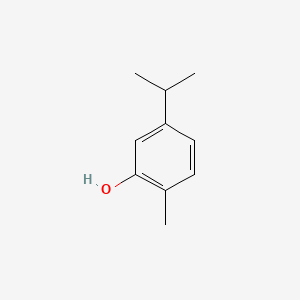Carvacrol
Carvacrol is a lipid of Prenol Lipids (PR) class. Carvacrol is associated with abnormalities such as Consumption-archaic term for TB, Disintegration (morphologic abnormality), Infection, Corn of toe and Candidiasis of vagina. The involved functions are known as Stereochemistry, Anabolism, Oxidation, Process and Binding (Molecular Function). Carvacrol often locates in Skin, Nerve Tissue, Membrane, Endothelium and Plasma membrane. The associated genes with Carvacrol are P4HTM gene, TRPV3 gene, TRPV1 gene, TRPV2 gene and TRPV4 gene. The related lipids are Fatty Acids, Lipopolysaccharides, Octanols, Micelles and butyrate.
References related to abnormalities published in Others
| PMID | Journal | Published Date | Author | Title |
|---|---|---|---|---|
| 17374894 | J. Med. Microbiol. | 2007 | Nostro A et al. | Effects of oregano, carvacrol and thymol on Staphylococcus aureus and Staphylococcus epidermidis biofilms. |
| 15456732 | J. Antimicrob. Chemother. | 2004 | Chami F et al. | Evaluation of carvacrol and eugenol as prophylaxis and treatment of vaginal candidiasis in an immunosuppressed rat model. |
| 21420431 | Pharmacol. Ther. | 2011 | Holzer P | Transient receptor potential (TRP) channels as drug targets for diseases of the digestive system. |
| 24759772 | Neuroscience | 2014 | Klein AH et al. | Eugenol and carvacrol excite first- and second-order trigeminal neurons and enhance their heat-evoked responses. |
| 26156773 | Proc. Biol. Sci. | 2015 | Patricelli D et al. | Plant defences against ants provide a pathway to social parasitism in butterflies. |
| 26146083 | Cell Rep | 2015 | Peng G et al. | Plant-Derived Tick Repellents Activate the Honey Bee Ectoparasitic Mite TRPA1. |
| 24631628 | Arch. Oral Biol. | 2014 | Zeidán-Chuliá F et al. | Focussed microarray analysis of apoptosis in periodontitis and its potential pharmacological targeting by carvacrol. |
